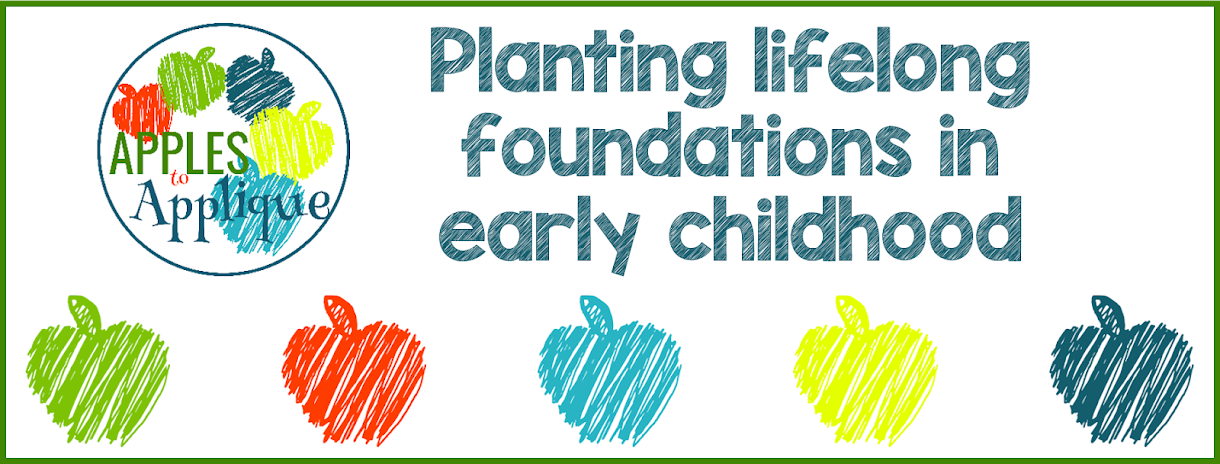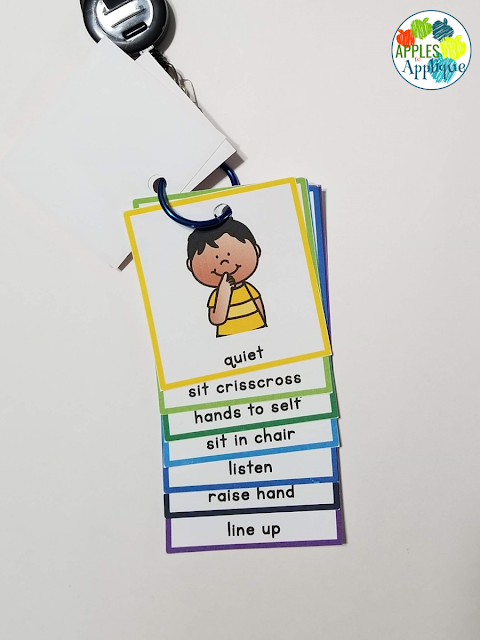I hear often about the importance of using visuals with students with special needs. It's true that visuals provide a good way to communicate with these kiddos, as some of them do better with processing an image than the spoken word. I like to take visuals one step further, and use them with all early childhood students. My classroom is made up of students with special needs, and those who are at risk, including a high number of ESOL students. I have found that all of them respond positively to visuals!
Visuals provide the advantage of actually showing students your expectation. I also love that they can be used to give a direction while you are still teaching. Often, in the middle of a lesson, I will hold up a visual to a student who is off-task, while not missing a beat with my instruction. This is why I LOVE the quick-reference design of these visuals in my Teachers Pay Teachers store!
Another powerful thing about visuals is that they lead to fewer power struggles and defiant behaviors. Students don't feel as challenged when presented with a visual as they do with a verbal command. They don't feel as much like they were called out in front of their peers; in fact, often times their classmates don't even notice the direction has been given, since the teacher is able to continue seamlessly with instruction. While this doesn't hold true 100% of the time, and of course some students will still choose to not listen, I have found that, by and large, a child who is calmly shown a visual to "sit" or "be quiet" will respond better to it than being told verbally to "sit" or "be quiet".
I attach these visuals to my lanyard so that they are always ready to go. When needed, I usually hold up the visual and give it a tap, then when the student complies I give a quick smile and a thumbs-up. We have an entire exchange without any words, and without them feeling embarrassed in front of their classmates. It's quick, easy, and effective.
If you have any experience with using visuals for behavior expectations in your classroom, I would love to hear about it! Drop me a comment below!
Sunday, February 17, 2019
Friday, February 8, 2019
Question of the Day
I am always on the lookout for ways to increase the rigor in my Pre-K
classroom. I have found time and again that my little learners are
capable of so much more than people realize. They can understand more
than people give them credit for, and I love expanding their minds with
new knowledge. I found this anonymous quote that says, "A mind when stretched by a new idea never regains its original dimensions".
That is powerful! I want to help my students expand their minds as much
as possible early in life, to give them more capacity for learning in
their future.
One easy way I do this in my classroom is through the use of a question of the day. On the surface, it sounds simple enough. I post a question on the board, and the students vote on their answer. But it encompasses so much more than that! Of course they cannot yet read it independently, so I read it to them while pointing to each word. This provides good exposure to print, and helps them learn basic print awareness skills, like reading from left to right, the fact that print represents spoken words, and that letters are grouped to form words. All of that, just from reading to them, and we haven't even gotten to answering the question yet!
Next, they get to think about answering the question. I give them questions that relate to things we are learning in the classroom, activating some prior knowledge first thing in the door, or questions that focus on skills they need to practice, such as letter recognition. I strive to use questions that do not have a set right or wrong answer, or at least, not the same right or wrong answer for every student. For example, we are currently in a unit about plants and gardening. I avoid questions like, "Which of these is one of the needs of a plant? Sun or rocks?" The reason I avoid these types of questions is that once a few kids answer, the rest of them will not stop to process the actual question. They will simply see where everyone else has put their counter, and follow suit.
Another way I use the Question of the Day to increase rigor is by
changing the method by which the students vote. Early in the year, when
they are still working on name recognition, I have magnets with each of
their names on them. They have to locate their name, and then use their
magnet to vote.
Later in the year, when they have mastered recognizing their own names, I switch it up. I have them vote by placing a cube in a balance, and we talk about how we know which side has more. My mathematician stacks the cubes to count the votes and we compare to see which tower is taller or shorter.
Currently I am having them vote by placing magnetic counters on a ten-frame. This gives them real-life practice with using a ten-frame; I watch as they vote to make sure they start in the top left corner, and fill in each space in order. When the class mathematician counts up the votes, we talk about strategies for subitizing using a ten-frame; i.e., "I see the whole top row of the ten-frame is full. How many is that?" "Can we count on from five to see how many we have all together?" "Wow, I love how Nyla subitized! She saw the ten-frame was full, so she knew ten friends voted for roses without having to count each one by itself".
To increase the rigor even further, we then talk about the concepts of greater than, less than, and equal. One of our Pre-K standards is comparing quantities, and once they have that down, I take it one step further by introducing the greater than and less than signs. This part is obviously not a Pre-K standard, so we don't spend a lot of time on it, but now my kids have been exposed to it and know how it works (yay for the good ol' "alligator mouth" analogy!). When they are introduced to these math symbols again a little later in their education, they will have some prior knowledge to access from their time in Pre-K, and be ready for greater challenges!
One of the most difficult things for me was coming up with a fresh new question every day. I finally took the time to compile a giant master list, and made a Question of the Day kit with more than enough questions to get through the entire school year. I even color-coded it, so it's super quick and easy to implement. Find it here!
Have you used a question of the day in your early childhood classroom? I would love to hear how it works for you!
One easy way I do this in my classroom is through the use of a question of the day. On the surface, it sounds simple enough. I post a question on the board, and the students vote on their answer. But it encompasses so much more than that! Of course they cannot yet read it independently, so I read it to them while pointing to each word. This provides good exposure to print, and helps them learn basic print awareness skills, like reading from left to right, the fact that print represents spoken words, and that letters are grouped to form words. All of that, just from reading to them, and we haven't even gotten to answering the question yet!
Next, they get to think about answering the question. I give them questions that relate to things we are learning in the classroom, activating some prior knowledge first thing in the door, or questions that focus on skills they need to practice, such as letter recognition. I strive to use questions that do not have a set right or wrong answer, or at least, not the same right or wrong answer for every student. For example, we are currently in a unit about plants and gardening. I avoid questions like, "Which of these is one of the needs of a plant? Sun or rocks?" The reason I avoid these types of questions is that once a few kids answer, the rest of them will not stop to process the actual question. They will simply see where everyone else has put their counter, and follow suit.
Later in the year, when they have mastered recognizing their own names, I switch it up. I have them vote by placing a cube in a balance, and we talk about how we know which side has more. My mathematician stacks the cubes to count the votes and we compare to see which tower is taller or shorter.
Currently I am having them vote by placing magnetic counters on a ten-frame. This gives them real-life practice with using a ten-frame; I watch as they vote to make sure they start in the top left corner, and fill in each space in order. When the class mathematician counts up the votes, we talk about strategies for subitizing using a ten-frame; i.e., "I see the whole top row of the ten-frame is full. How many is that?" "Can we count on from five to see how many we have all together?" "Wow, I love how Nyla subitized! She saw the ten-frame was full, so she knew ten friends voted for roses without having to count each one by itself".
To increase the rigor even further, we then talk about the concepts of greater than, less than, and equal. One of our Pre-K standards is comparing quantities, and once they have that down, I take it one step further by introducing the greater than and less than signs. This part is obviously not a Pre-K standard, so we don't spend a lot of time on it, but now my kids have been exposed to it and know how it works (yay for the good ol' "alligator mouth" analogy!). When they are introduced to these math symbols again a little later in their education, they will have some prior knowledge to access from their time in Pre-K, and be ready for greater challenges!
One of the most difficult things for me was coming up with a fresh new question every day. I finally took the time to compile a giant master list, and made a Question of the Day kit with more than enough questions to get through the entire school year. I even color-coded it, so it's super quick and easy to implement. Find it here!
Have you used a question of the day in your early childhood classroom? I would love to hear how it works for you!
Subscribe to:
Posts (Atom)






